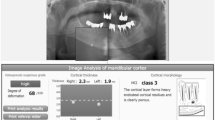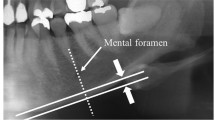Abstract
Introduction
Osteoporosis and tooth loss have been linked with advancing age, but no clear relationship between these conditions has been proven. Several studies of bone mineral density measurements of the jaw and spine have shown similarities in their rate of age-related deterioration. Thus, measurements of jawbone density may predict lumbar vertebral bone density. Using jawbone density as a proxy marker would circumvent the need for lumbar bone measurements and facilitate prediction of osteoporotic spinal fracture susceptibility at dental clinics. We aimed to characterize the correlation between bone density in the jaw and spine and the incidence of osteoporotic spinal fractures.
Methods
We used computerized radiogrammetry to measure alveolar bone mineral density (al-BMD) and dual-energy X-ray absorptiometry to measure lumbar bone mineral density (L-BMD). L-BMD and al-BMD in 30 female patients (average age: 59 ± 5 years) were correlated with various patient attributes. Statistical analysis included area under the curve (AUC) and probability of asymptomatic significance (PAS) in a receiver operating characteristic curve. The predictive strength of L-BMD T-scores (L-BMD[T]) and al-BMD measurements for fracture occurrence was then compared using multivariate analysis with category weight scoring.
Results
L-BMD and al-BMD were significantly correlated with age, years since menopause, and alveolar bone thickness. Both were also negatively correlated with fracture incidence. Category weight scores were −0.275 for a L-BMD(T) <80%; +0.183 for a L-BMD(T) ≥80%; −0.860 for al-BMD <84.9 (brightness); and +0.860 for al-BMD ≥84.9. AUC and PAS analyses suggested that al-BMD had a higher association with fracture occurrence than L-BMD.
Conclusions
Our results suggest the possible association between al-BMD and vertebral fracture risk. Assessment of alveolar bone density may be useful in patients receiving routine dental exams to monitor the clinical picture and the potential course of osteoporosis in patients who may be at a higher risk of developing osteoporosis.




Similar content being viewed by others
References
Jeffcoat MK. Osteoporosis: a possible modifying factor in oral bone loss. Ann Periodontol. 1998;3:312–21.
Martinez-Maestre MA, Gonzalez-Cejudo C, Machuca G, Torrejon R, Castelo-Branco C. Periodontitis and osteoporosis: a systematic review. Climacteric. 2010;13:523–9.
Krall EA, Garcia RI, Dawson-Hughes B. Increased risk of tooth loss is related to bone loss at the whole body, hip, and spine. Calcif Tissue Int. 1996;59:433–7.
Krall EA, Dawson-Hughes B, Papas A, Garcia RI. Tooth loss and skeletal bone density in healthy postmenopausal women. Osteoporos Int. 1994;4:104–9.
Groen JJ, Duyvensz F, Halsted JA. Diffuse alveolar atrophy of the jaw (non-inflammatory form of paradental disease) and pre-senile osteoporosis. Gerontol Clin. 1960;2:68–86.
Taguchi A, Suei Y, Ohtsuka M, Otani K, Tanimoto K, Hollender LG. Relationship between bone mineral density and tooth loss in elderly Japanese women. Dentomaxillofac Radiol. 1999;28:291–300.
Nicopoulou-Karayianni K, Tzoutzoukos P, Mitsea A, et al. Tooth loss and osteoporosis: the OSTEODENT study. J Clin Periodontol. 2010;36:190–7.
Megson E, Kapellas K, Bartold PM. Relationship between periodontal disease and osteoporosis. Int J Evid Based Healthc. 2010;8:129–39.
Habashneh RA, Alchalabi H, Khaden YS, Hazza’a AM, Odat Z, Johnson GK. Association between periodontal disease and osteoporosis in postmenopausal women in Jordan. J Periodontol. 2010;81:1613–21.
Kribbs PJ, Smith DE, Chesnut CH 3rd. Oral findings in osteoporosis. Part I: measurement of mandibular bone density. J Prosthet Dent. 1983;50:576–9.
Manzke E, Chesnut CH III, Wergedal JE, Baylink DJ, Nelp WB. Relationship between local and total bone mass in osteoporosis. Metabolism. 1975;24:605–15.
Klemetti E, Vainio P. Effect of bone mineral density in skeleton and mandible on extraction of teeth and clinical alveolar height. J Prosthet Dent. 1993;70:21–5.
Earnshaw SA, Keating N, Hosking DJ, et al. Tooth counts do not predict bone mineral density in early postmenopausal Caucasian women. EPIC study group. Int J Epidemiol. 1998;27:479–83.
Jonasson G, Alstad T, Vahedi F, Bosaeus I, Lissner L, Hakeberg M. Trabecular pattern in the mandible as bone fracture predictor. Oral Surg Oral Med Oral Pathol Oral Radiol Endod. 2009;108:e42–51.
Verheij JG, Geraets WG, van der Stelt PF, et al. Prediction of osteoporosis with dental radiographs and age. Dentomaxillofac Radiol. 2009;38:431–7.
Jonasson G, Kiliaridis S, Gunnarsson R. Cervical thickness of the mandibular alveolar process and skeletal bone mineral density. Acta Odontol Scand. 1999;57:155–61.
Cakur B, Dagistan S, Sahin A, Harorli A, Yilmaz A. Reliability of mandibular cortical index and mandibular bone mineral density in the detection of osteoporotic women. Dentomaxillofac Radiol. 2009;38:255–61.
Vlasiadis KZ, Skouteris CA, Velegrakis GA, et al. Mandibular radiomorphometric measurements as indicators of possible osteoporosis in postmenopausal women. Maturitas. 2007;58:226–35.
Horner K, Karayianni K, Mitsea A, et al. The mandibular cortex on radiographs as a tool for osteoporosis risk assessment: the OSTEODENT Project. J Clin Densitom. 2007;10:138–46.
Yasar F, Akgunlu F. The differences in panoramic mandibular indices and fractal dimension between patients with and without spinal osteoporosis. Dentomaxillofac Radiol. 2006;35:1–9.
Taguchi A, Ohtsuka M, Tsuda M, et al. Risk of vertebral osteoporosis in post-menopausal women with alterations of the mandible. Dentomaxillofac Radiol. 2007;36:143–8.
Pluskiewicz W, Tarnawska B, Drozdzowska B. Mandibular bone mineral density measured using dual-energy X-ray absorptiometry: relationship to hip bone mineral density and quantitative ultrasound at calcaneus and hand phalanges. Br J Radiol. 2000;73:288–92.
Binte Anwar R, Tanaka M, Kohno S, et al. Relationship between porotic changes in alveolar bone and spinal osteoporosis. J Dent Res. 2007;86:52–7.
Miliuniene E, Alekna V, Peciuliene V, Tamulaitiene M, Maneliene R. Relationship between mandibular cortical bone height and bone mineral density of lumbar spine. Stomatologija. 2008;10:72–5.
Persson GR, Berglund J, Persson RE, Renvert S. Prediction of hip and hand fractures in older persons with or without a diagnosis of periodontitis. Bone. 2011;48:552–6.
Modano DE, Irigoyen ME, Borges-Yanez A, Flores-Sanchez I, Rotter RC. Osteoporosis, the risk of vertebral fracture, and periodontal disease in an elderly group in Mexico City. Gerodontology. 2011;28:19–27.
Okabe S, Morimoto Y, Ansai T, et al. Assessment of the relationship between the mandibular cortex on panoramic radiographs and the risk of bone fracture and vascular disease in 80-year olds. Oral Surg Oral Med Oral Pathol Oral Radiol Endod. 2008;106:433–42.
Takaishi Y, Ikeo T, Nakajima M, Miki T, Fujita T. A pilot case-control study on the alveolar bone density measurement in risk assessment for bisphosphonate-related osteonecrosis of the jaw. Osteoporos Int. 2010;21:815–25.
Takaishi Y, Okamoto Y, Ikeo T, et al. Correlations between periodontitis and loss of mandibular bone in relation to systemic bone changes in postmenopausal Japanese women. Osteoporos Int. 2005;16:1875–82.
Takaishi Y, Ikeo T, Miki T, Nishizawa Y, Morii H. Suppression of alveolar bone resorption by etidronate treatment for periodontal disease: 4- to 5-year follow-up of four patients. J Int Med Res. 2003;31:575–84.
Genant HK, Wu CY, van Kuijk C, Nevitt MC. Vertebral fracture assessment using a semiquantitative technique. J Bone Miner Res. 1993;8:1137–48.
Ohishi T, Takahashi M, Kawana K, et al. Age-related changes of urinary pyridinoline and deoxypyridinoline in Japanese subjects. Clin Invest Med. 1993;16:319–25.
Garnero P, Delmas PD. Assessment of the serum levels of bone alkaline phosphatase with a new immunoradiometric assay in patients with metabolic bone disease. J Clin Endocrinol Metab. 1993;77:1046–53.
Fukunaga M, Nakamura T, Shiraki M, et al. Absolute height reduction and percent height ratio of the vertebral body in incident fracture in Japanese women. J Bone Miner Metab. 2004;22:104–10.
Acknowledgments
We thank Dr. Tim Werry, Dr. Rebecca Jackson, and Mrs. Yayoi Takaishi for editorial support in the preparation of this manuscript. No funding or sponsorship was received for this study or publication of this article. Dr. Yoshitomo Takaishi is the guarantor for this article and takes responsibility for the integrity of the work as a whole.
Conflict of interest
Dr. Yoshitomo Takaishi, Dr. Seizaburo Arita, Dr. Mitsugi Honda, Dr. Takeshi Sugishita, Dr. Aiko Kamada, Dr. Takashi Ikeo, Dr. Takami Miki, and Dr. Takuo Fujita declare no conflict of interest.
Compliance with Ethics Guidelines
All procedures followed were in accordance with the ethical standards of the responsible committee on human experimentation (institutional and national) and with the Helsinki Declaration of 1975, as revised in 2000. Informed consent was obtained from all patients for being included in the study. This study was approved by the Institutional Review Board of Katsuragi Hospital.
Author information
Authors and Affiliations
Corresponding author
Rights and permissions
About this article
Cite this article
Takaishi, Y., Arita, S., Honda, M. et al. Assessment of Alveolar Bone Mineral Density as a Predictor of Lumbar Fracture Probability. Adv Ther 30, 487–502 (2013). https://doi.org/10.1007/s12325-013-0028-1
Received:
Published:
Issue Date:
DOI: https://doi.org/10.1007/s12325-013-0028-1




